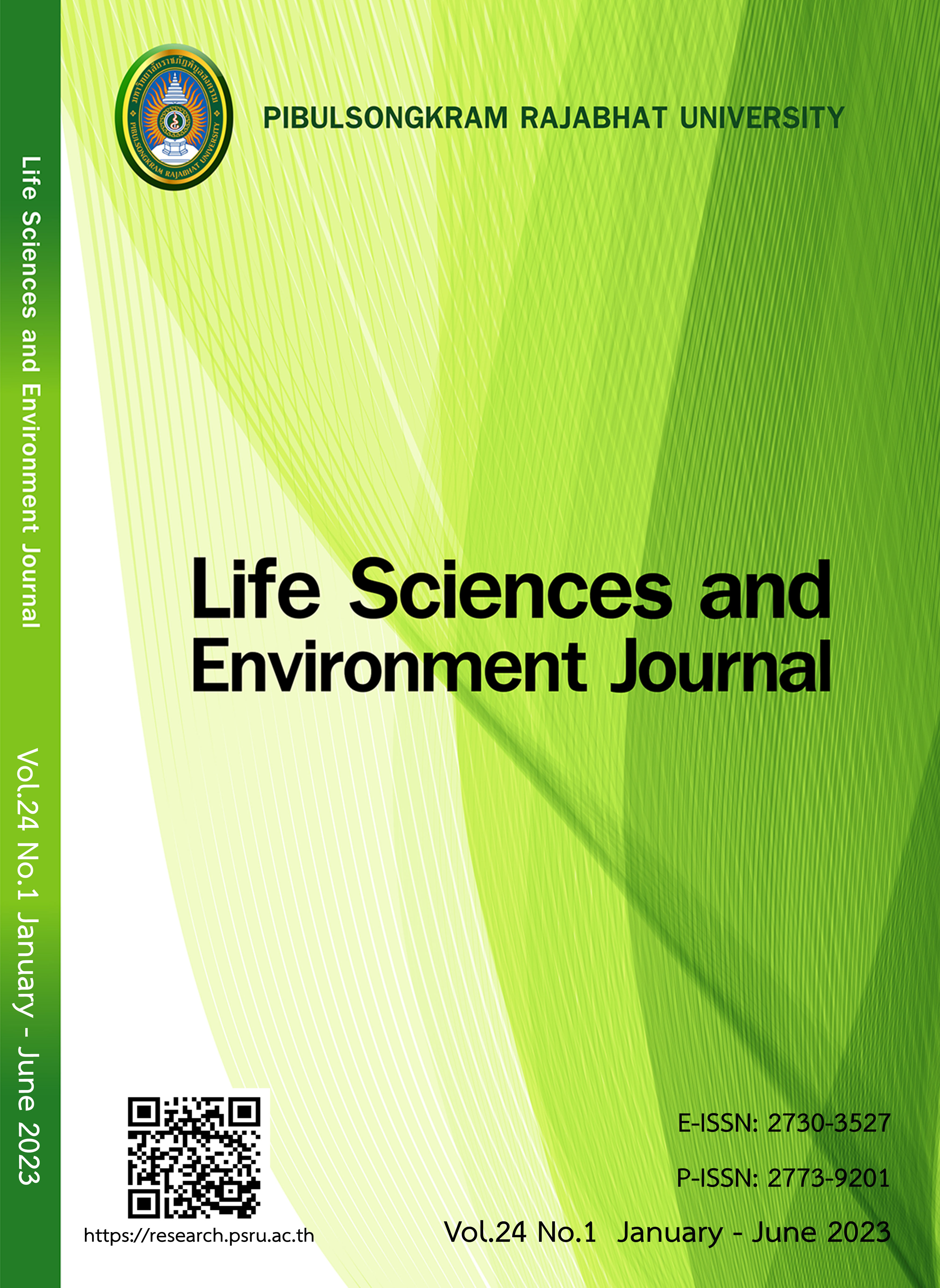EFFECTS OF BIOACTIVE COMPOUNDS IN POWDERED EXTRACTS YOUNG MANGO LEAVES TO DEVELOP DIETARY SUPPLEMENTS
DOI:
https://doi.org/10.14456/lsej.2023.8Keywords:
Young mango leaf, Dietary supplement, Bioactive compound, Alpha-glucosidaseAbstract
Mangiferin is a phenolic compound that abundant in mango leaves and endowed with a wide range of bioactivities. This research aimed to study the potential of extracts of 5 varieties of mango in order to develop supplementary products. The young leaves of 5 local varieties of mango were prepared as tea. The extraction was achieved by using the microwave technique and powdered by freeze-drying technique. The phytochemical and biological activities of water extracts were studied. The greatest extract percentage, 26%, was obtained by Khiew Sawoei. The results of thin-layer chromatography, found that the main substance was phenolic compounds, xanthones and flavonoids. A Comparison of Fourier Transform Infrared (FTIR) Spectroscopy technique was found to similar IR spectrum of mangiferin. In addition, the study of total phenolic content, antioxidant activity and inhibition of α-glucosidase and α-amylase found that Khiew Sawoei and Nam Dok Mai showed the highest content of total phenolic compound and outstanding activities especially the inhibitory effect of α-glucocidase which higher than acarbose 10 times (p<0.05). In the future, mango young leaf extract may be created as a dietary supplement for diabetic patients and the elderly.
References
Barreto JC, Trevisan MTS, Hull WE, Erben G, de Brito ES, Pfundstein B, Würtele G, et al. Characterization and quantitation of polyphenolic compounds in bark, kernel, leaves, and peel of mango (Mangifera indica L.). Journal of Agricultural and Food Chemistry 2008;56:5599-5610.
Berardini N, Carle R, Schieber A. Characterization of gallotannins and benzophenone derivatives from mango (Mangifera indica L. cv. ‘Tommy Atkins’) peels, pulp and kernels by high-performance liquid chromatography/electrospray ionization mass spectrometry. Rapid Communication in Mass Spectrometry 2004;18:2208-2216.
Braca A, Sortino C, Politi M, Morelli I, Mendez J. Antioxidant activity of flavonoids from Licania licaniaeflora. Journal of Ethnopharmacology 2002;79(3):379-381.
Fraga CG, Galleano M, Verstraeten SV, Oteiza PI. Basic biochemical mechanisms behind the health benefits of polyphenols. Molecular Aspects of Medicine 2010;31:435-445.
Gella FJ, Gubern G, Vidal R, Canalias F. Determination of total and pancreatic α-amylase in human serum with 2-chloro-4-nitrophenyl-α-D-maltotrioside as substrate. Clinica Chimica Acta 1997;259: 147-160.
Gua C, YangaM, Zhouc Z, Khand A, Caoa J, Chenga G. Purification and characterization of four benzophenone derivatives from Mangifera indica L. leaves and their antioxidant, immunosuppressive and α-glucosidase inhibitory activities. Journal of Functional Foods 2019;52:709-714.
Hannan A, Asghar S, Naeem T, Ullah MI, Ahmed I, Syeda Aneela S, Hussain S. Antibacterial effect of mango (Mangifera indica Linn.) leaf extract against antibiotic sensitive and multi-drug resistant Salmonella typhi. Pakistan Journal of Pharmaceutical Sciences 2013;26(4):715-719.
Hesham RE, Mohamed AS, Omar MK. Dietary Xanthones. Handbook of Dietary Phytochemicals 2020:1-22.
Imran M, Arshad MS, Butt MS, Kwon JH, Arshad MU, Sultan MT. Mangiferin: a natural miracle bioactive compound against lifestyle related disorder. Lipids in Health and Disease 2017;16(84):1-17.
Kanwal Q, Hussain I, Siddiqui HL, Javaid A. Flavonoids from mango leaves with antibacterial activity. Journal of the Serbian Chemical Society 2009;74(12):1389-1399.
Kulkarni VM, Rathod VK. Exploring the potential of Mangifera indica leaves extract versus mangiferin for therapeutic application. Agriculture and Natural Resources. 2018;52:155-161.
Kumar M, Saurabh V, Tomar M, Hasan M, Changan S, Sasi M, Maheshwari C. et al. Mango (Mangifera indica L.) leaves: nutritional composition, phytochemical profile, and health-promoting bioactivities antioxidants. 2021;10(299):1-23.
Majhenic L, Skerget M, Knez Z. Antioxidant and antimicrobial activity of quarana seed extracts. Food Chemistry 2007;104(3):1258-1268.
Matkowski A, Kus P, Goralska E, Wozniak D. Mangiferin-a bioactive xanthonoid, not only from mango and not just antioxidant. Mini-Reviews in Medicinal Chemistry 2013;13:439-455.
Matsui T, Yoshimoto C, Osajima K, Oki T, Osajima Y. In vitro survey of alpha-glucosidase inhibitory food components. Bioscience Biotechnology Biochemistry 1996;60 2019-2022.
Panche AN, Diwan AD, Chandra SR. Flavonoids: an overview. Journal of Nutritional Science 2016;5(47):1-15.
Samanta S, Ranabir CR, Ganguli S, Reddy AG, Banerjee J. Anti-diabetic activity of mango (Mangifera indica): a review. MOJ Bioequivalence & Bioavailability 2019;6(2):23-26.
Santos CMM, Freitas M, Fernandes E. A comprehensive review on xanthone derivatives as α-glucosidase inhibitors. European Journal of Medicinal Chemistry 2018;157(5):1460-1479.
Swaroop A, Stohs SJ, Bagchi M, i Moriyama H, Bagchi D. Mango (Mangifera indica Linn) and anti-inflammatory benefits: versatile roles in mitochondrial bio-energetics and exercise physiology. Functional Foods in Health and Disease 2018;8(5):267-279.
Zeb A. Concept, mechanism, and applications of phenolic antioxidants in foods. Journal of Food Biochemistry 2020;44(9):e13394.
Downloads
Published
How to Cite
Issue
Section
License
Copyright (c) 2023 Life Sciences and Environment Journal

This work is licensed under a Creative Commons Attribution-NonCommercial-NoDerivatives 4.0 International License.
Each article is copyrighted © by its author(s) and is published under license from the author(s).










